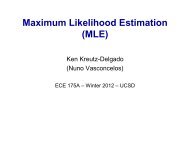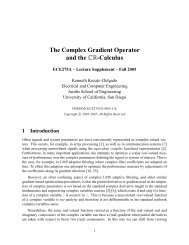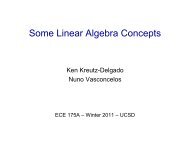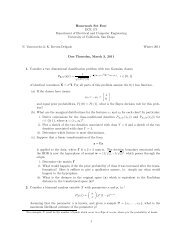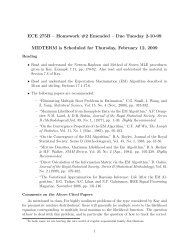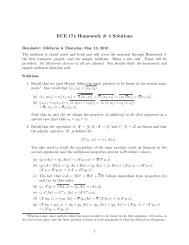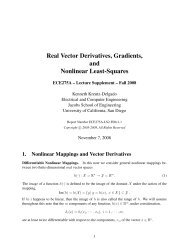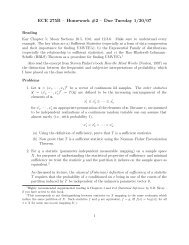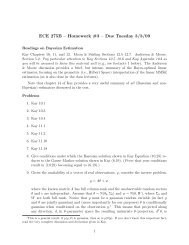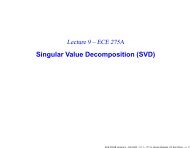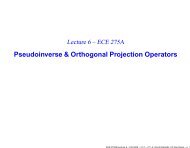ECE 275A Homework #4 Solutions V1.1 – Fall 2008 - UCSD DSP Lab
ECE 275A Homework #4 Solutions V1.1 – Fall 2008 - UCSD DSP Lab
ECE 275A Homework #4 Solutions V1.1 – Fall 2008 - UCSD DSP Lab
You also want an ePaper? Increase the reach of your titles
YUMPU automatically turns print PDFs into web optimized ePapers that Google loves.
<strong>ECE</strong> <strong>275A</strong> <strong>Homework</strong> <strong>#4</strong> <strong>Solutions</strong> <strong>V1.1</strong> <strong>–</strong> <strong>Fall</strong> <strong>2008</strong><br />
<strong>Homework</strong> <strong>Solutions</strong><br />
1. (a) We have<br />
Thus for all x<br />
ℓ(x) = x H Πx − 2Re x H By + y H W y<br />
= x H Πx − x H By − y H B H x + y H W y<br />
= x H Πx − x H Π Π −1 By − y H B H Π −1 Πx + y H W y<br />
= x − Π −1 By H Π x − Π −1 By + y H W y − y H B H Π −1 By<br />
= x − Π −1 By H Π x − Π −1 By + y H W − B H Π −1 B y<br />
ℓ(x) ≥ y H W − B H Π −1 B y<br />
with equality if and only if x = Π −1 By. Thus we have proved that<br />
ˆx = Π −1 By = arg min<br />
x ℓ(x)<br />
ℓ(ˆx) = y H W − B H Π −1 B y = min<br />
x ℓ(x)<br />
(b) It is straightforward to apply this result to the full column-rank, weighted leastsquares<br />
problem.<br />
ℓ(x) = y − Ax 2 W = (y − Ax) H W (y − Ax)<br />
= x H A H W A<br />
<br />
Π<br />
x − x H A H W<br />
<br />
B<br />
= x H Πx − x H By − y H B H x + y H W y<br />
= x H Πx − 2Re x H By + y H W y<br />
y − y H W A<br />
BH x + y H W y<br />
With A full column rank and W = W H > 0, the matrix Π is Hermitian and full<br />
rank. Thus the weighted least-squares estimate of x is<br />
ˆx = Π −1 By = A H W A −1 A H W y<br />
with optimal (minimal) least-squares cost<br />
Comment.<br />
Suppose that<br />
ℓ(ˆx) = y H W − B H Π −1 B y = y H W − W A(A H W A) −1 A H W y<br />
〈y1, y2〉 = y H 1 W y2 and 〈x1, x2〉 = x H 1 x 2<br />
1<br />
(i.e., Ω = I)
Then<br />
A ∗ = A H W<br />
A + = (AA ∗ ) −1 A ∗ = (A H W A) −1 A H W<br />
PR(A) = AA + = A(A H W A) −1 A H W<br />
PN (A ∗ ) = I − PR(A)<br />
This shows that the optimal cost can be rewritten as<br />
or<br />
ℓ(ˆx) = y H W (I − PR(A))y<br />
= y H W PN (A ∗ )y<br />
= 〈y, P 2 N (A ∗ )〉<br />
= 〈P ∗ N (A ∗ )y, PN (A ∗ )〉<br />
= 〈PN (A ∗ )y, PN (A ∗ )<br />
ℓ(ˆx) = PN (A ∗ )y 2 = PN (A ∗ )y 2 W<br />
What is the optimal cost if y ∈ R(A)? Does this make sense?<br />
Note that the optimal error (which must be orthogonal to the range of A) is<br />
ê = y − ˆy = y − PR(A)y = (I − PR(A))y = PN (A ∗ )y<br />
Therefore the optimal cost can also be written as<br />
ℓ(ˆx) = ê 2 = ê 2 W<br />
showing that the optimal least-squares error is the minimal residual error “power”.<br />
2. As in lecture, define the derivative with respect to a vector to be a row operator,<br />
∂<br />
∂x =<br />
<br />
∂<br />
, · · · ,<br />
∂x1<br />
∂<br />
<br />
.<br />
∂xn<br />
An equivalent statement to Entry 1 in Table E.1, would be an identity involving the<br />
undefined expression ∂<br />
∂x xT A (the derivative of a row vector with respect to a row<br />
vector), which is not sensible within our framework as it has been developed so far.<br />
To make this expression sensible, we would have to expand our framework to include<br />
new operations and/or new objects in addition to scalars, vectors, row-vectors, and<br />
matrices. The usual extension is the standard tensor calculus, which we will not<br />
discuss. 1<br />
1 The derivative of a row-vector (a covector in tensor calculus parlance) by a row-vector is not a matrix<br />
which is a rank-2 tensor known as a (1, 1)-tensor, but a different type of rank-2 tensor known as a (0, 2)-tensor.<br />
2
The equivalent identities to Equation (E.4) and Entry 2 of Table E.1,<br />
∂<br />
∂x cT x = c T<br />
and<br />
∂<br />
Ax = A<br />
∂x<br />
are both easily proved at the component level. We can also prove Entry 2 from Equation<br />
(E.4) in two ways. Either apply (E.4) component-wise to Ax or note that for an<br />
arbitrary vector d, we have ∂<br />
∂x dT Ax = d T A.<br />
One can also easily prove the equivalent statement to Entry 4 at the component level.<br />
We have<br />
or<br />
∂ <br />
aij xi xj =<br />
∂xk<br />
<br />
aik xi + <br />
akj xj + 2 akk xk = <br />
aik xi + <br />
i<br />
j<br />
i=k<br />
j=k<br />
i<br />
j<br />
akj xj<br />
∂<br />
∂x xT Ax = x T A + x T A T<br />
which is the result to be proved. By setting A = I we therefore have the equivalent<br />
result to Entry 3,<br />
∂<br />
∂x xT x = ∂<br />
∂x x2 = 2x T .<br />
By assuming that A is symmetric we obtain the equivalent result to Entry 5,<br />
∂<br />
∂x xT Ax = ∂<br />
∂x x2A = 2x T A .<br />
Finally, the chain rule for differentiating z = z(y(x)) with respect to x (which is<br />
equivalent to Entry 6),<br />
∂z ∂z ∂y<br />
=<br />
∂x ∂y ∂x ,<br />
(equivalently, in terms of jacobian matrices, Jz◦y = Jz Jy), follows from the componentlevel<br />
expression given at the very top of page 897 in Moon.<br />
3. Note that Entry 2 in Table E.1 is not really well-defined within the vector-matrix<br />
framework developed in Moon & Stirling as they have not explained what it means to<br />
take the derivative of a row vector by a column vector. 2 To do so in a consistent manner<br />
2In class we define how to take the derivative of a column vector f(x) with respect to a column vector<br />
x as the action of the (row) partial derivative operator ∂ on the vector f(x). Similarly, Moon & Stirling<br />
∂x<br />
also define the derivative of a column vector respect to a column vector—this is done right at the outset<br />
of Appendix E. Thereafter, all additional identities provided by Moon & Stirling should be consistent with<br />
that definition. According to Identities 1 and 2 of Table E.1, the derivative of the column vector AT x (note<br />
the transpose on A here) with respect to the column vector x and the derivative of the row vector xT A<br />
with respect to the column vector x both give the same mathematical object A. Since row and column<br />
vectors generally correspond to different mathematical objects, this result requires some explanation or<br />
3
equires either extending the vector-matrix results of Appendix E or introducing tensorlike<br />
concepts. 3<br />
Also note that the last entry in Table E.1 uses an egregious notation in the parenthetical<br />
comment. A better notation is z = z(y) and y = y(x), in which case the given identity<br />
(which is proved on page 897 of Moon) makes sense.<br />
For completeness, the second (as it stands, not well defined) entry in Table E.1 can be<br />
replaced by Equation E.3.<br />
Note that with the Cartesian coordinate system assumption that Ω = I, one can easily<br />
convert the row-vector derivative identities derived in the previous homework problem<br />
into the corresponding column-vector derivative identities by simply transposing the<br />
identities (possible with some minor renaming).<br />
Alternatively, one can prove the column-vector derivative identities directly. From<br />
Moon & Stirling’s Identity E.3 (which is proved in the book), Entry 1 of the table<br />
easily follows by noting that for an arbitrary vector c we have<br />
∇x c T Ax = ∇x (A T c) T x = A T c<br />
which (since c is arbitrary) yields the desired identity ∇x Ax = A T .<br />
Entry 4 is proved at the component level using the same argument given in the previous<br />
homework problem. Entries 3 and 5 of Table E.1 are just special cases of Entry 4.<br />
4. See the Lecture 10 viewgraphs.<br />
5. In the following Let H = [h1, · · · , hn].<br />
(a) Note that as stated this situation does not involve a linear mapping H and therefore<br />
there is no domain space and no codomain space. 4 What we do have, according<br />
to the problem statement, is an ambient Hilbert space Y = C m and an<br />
n-dimensional Hilbert subspace of this space, H ⊂ Y, given by<br />
H = span {h1, · · · , hn} ,<br />
interpretation. In essence, the distinction between a row vector (an object which transforms covariantly) and<br />
a column vector (an object which transforms contravariantly) is being ignored in Moon & Stirling (which is<br />
ok in a Cartesian coordinate system). In Moon & Stirling, the distinction between matrix A as a bilinear<br />
functional of two column vectors and as a bilinear functional on a row vector and a column vector has been<br />
blurred.<br />
3 The identity, properly interpreted, is not false. Without further elaboration, we just don’t quite know<br />
what it means. Indeed, it can formally, and easily, be proved as follows: ∇xx T Ac = ∇xc T A T x = (A T c) T =<br />
c T A, which is true for all c, and therefore ∇xx T A = A.<br />
4 The concepts of domain and codomain presuppose the existence of a mapping.<br />
4
where hi, i = 1, · · · , n are linearly independent (and therefore form a basis for<br />
H).<br />
The optimal approximation of x, ˆx = θ1h1 + · · · θnhn, in the subspace spanned by<br />
h1, · · · , hn is determined from the orthogonality condition,<br />
x − ˆx = x − (θ1h1 + · · · θnhn) = x − Hθ ⊥ Span {h1, · · · , hn} = R(H) .<br />
This condition is equivalent to the requirement that<br />
or, equivalently,<br />
〈x − Hθ, hi〉 = (x − Hθ) H C −1 hi = 0 , for i = 1, · · · , n ,<br />
(x − Hθ) H C −1 [h1, · · · , hn] = (x − Hθ) H C −1 H = 0 .<br />
This yields the normal equations,<br />
so that,<br />
H H C −1 H ˆ θ = H H C −1 x ,<br />
x = H ˆ θ = H(H H C −1 H) −1 H H C −1 x = HH + x = PR(H)x .<br />
(b) This derivation should be standard for you by now.<br />
(c) Here we need just need to expand the loss function J = (x−Hθ) H C −1 (x−Hθ) into<br />
separate terms and then make the identification with the terms of the resulting<br />
quadratic form exactly as done in the solution to Problem 1 given above.<br />
5



